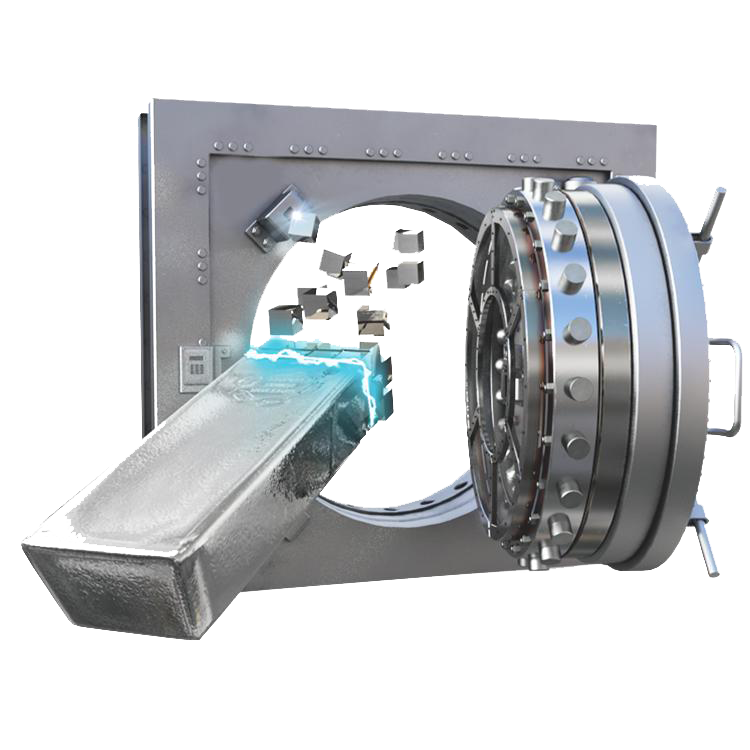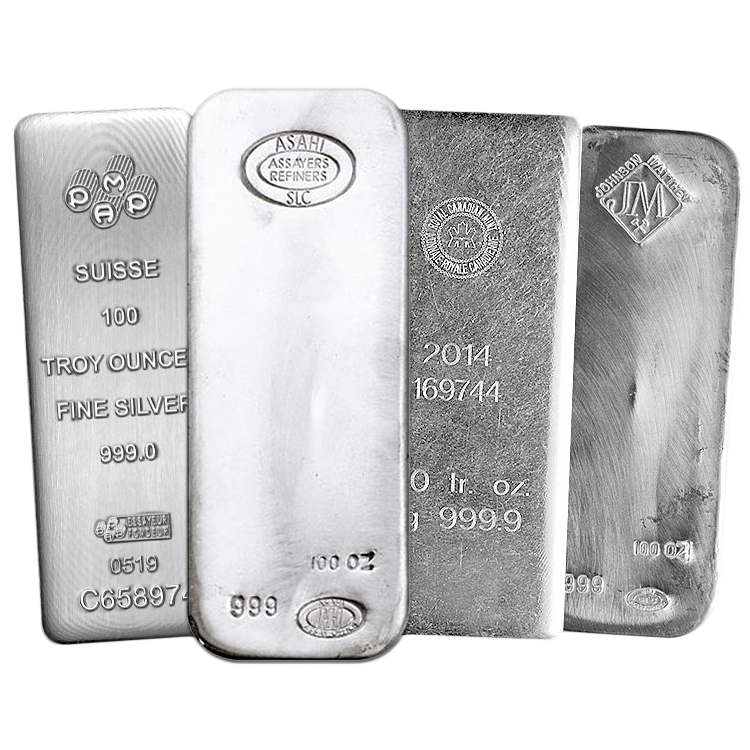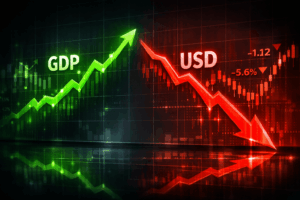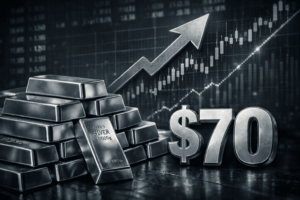Gold has recently hit record highs, up 41% over the past year and 113% this decade, outperforming the S&P 500’s 78% return. Historical patterns suggest silver may soon follow and potentially outperform gold.
Silver typically lags gold during market downturns but often outshines it during recoveries due to its dual role as both a precious metal and industrial commodity used in electronics and solar energy. The current gold-silver ratio of 98:1 far exceeds the 30-year average of 68:1, indicating silver may be undervalued.
This pattern has consistently repeated after previous market crises. Following the 2020 COVID panic, silver surged 73% while gold rose just 8%. After the 2008 financial crisis, silver jumped 81% versus gold’s 44%. Despite silver’s vulnerability to economic downturns due to its industrial applications, history shows it typically rebounds strongly as recovery takes hold.
A Proven Pattern: Silver Often Follows — Then Outruns — Gold
During periods of recovery and monetary uncertainty, silver has a habit of trailing gold’s rise—only to eventually outpace it. After the 2020 COVID crash, gold climbed 8%, while silver rocketed 73%. Following the 2008 financial crisis, silver surged 81% compared to gold’s 44%.
Why the lag-then-leap dynamic? It comes down to silver’s unique role in the global economy.
Unlike gold, which is primarily a monetary metal, silver straddles two worlds: it’s both a store of value and an essential industrial resource.
The Industrial Engine Behind Silver’s Strength
Silver’s growing use in technology and green energy makes it increasingly indispensable in the modern economy. That industrial utility gives silver a support system gold simply doesn’t have.
- Renewable Energy: Silver is vital to solar energy production, with each photovoltaic panel containing roughly 20 grams of the metal. As governments and corporations worldwide ramp up clean energy initiatives, demand for silver in solar panels is projected to surge.
- Electronics and Technology: From smartphones to electric vehicles, silver’s unmatched conductivity makes it foundational in electronics manufacturing. As global tech adoption expands, so too does the baseline demand for silver—an underlying force independent of investor sentiment.
- Medical Applications: Silver’s antimicrobial properties have led to rising usage in medical equipment, bandages, and even hospital air filtration systems. The pandemic spotlighted these properties, and demand has only grown in its wake.
These industrial drivers not only broaden silver’s demand base—they help support prices, even in volatile markets. According to MarketWatch, if industrial consumption continues to rise while supply remains constrained, silver could see significant price tailwinds in the years ahead.
Supply Constraints: The Overlooked Silver Shortage
Persistent Deficits in a Tighter Market
Silver has quietly slipped into structural deficit territory. For five straight years, global demand has outpaced supply, with the market expected to see another shortfall in 2025. In 2023 alone, the deficit hit 184.3 million ounces. This year’s projected gap? Around 215 million ounces — the second-largest on record. These aren’t one-off imbalances; they point to deeper supply-side challenges that aren’t easy to fix.
Mining Isn’t Keeping Up
Silver mining production peaked in 2016 and has declined about 7% since. And despite rising prices, output remains subdued. Why? Because roughly 75% of silver comes as a byproduct from mining other metals like copper and zinc. That means silver supply doesn’t respond directly to silver prices—it depends on the economics of other metals. So even if silver prices spike, production doesn’t necessarily follow.
Lower Grades, Higher Costs
Another constraint: silver ore quality is declining. The average grade at the top 12 global projects has dropped 36% over the past decade, while reserve grades are down nearly 40%. Extracting silver is becoming more expensive, and many mining operations now face rising costs and shrinking margins — some even running at negative cash flow, despite higher silver prices.
Dwindling Inventories and Recycling Limits
To fill the gap, the market is increasingly tapping above-ground inventories. But that well isn’t bottomless. If demand continues on its current trajectory, those reserves could be significantly depleted within a year. Recycling offers some relief, but it’s not nearly enough to close the widening gap between supply and demand.
A Slow Supply Response
Even if miners wanted to boost production today, it wouldn’t happen overnight. New silver projects take years to develop. Industry analysts agree: it’s unlikely that new production will offset current deficits anytime soon. In the meantime, the market remains reliant on recycling and stockpiles—both of which are under growing pressure.
This tightening supply backdrop, coupled with rising industrial and investment demand, points to a potentially powerful setup for silver. For investors seeking undervalued assets with long-term upside, that’s a story worth watching.

Wait! Don't Forget Your Free Book
Mike Maloney's #1 all-time bestselling investment guide.
An Overlooked Opportunity in the Gold-Silver Ratio
Perhaps the clearest signal that silver is undervalued is the gold-silver ratio—the number of silver ounces it takes to buy one ounce of gold. Sitting near 98:1, it’s well above the 30-year average of 68:1. Historically, when the ratio stretches this far, it doesn’t stay there for long.
When it reverts, it tends to do so swiftly — and in silver’s favor. For strategic investors, this isn’t just an anomaly. It’s an opportunity.
Why Silver Deserves a Spot in a Diversified Strategy
In today’s macro environment — marked by record debt, global currency debasement, and geopolitical shifts — physical assets are making a powerful case. Central banks are stacking gold, but many individual investors are turning to silver as a more accessible, higher-upside hedge.
Silver’s lower entry point makes it especially appealing for newer investors. And thanks to innovations like InstaVault, which lets you dollar-cost average into silver with low spreads and flexible storage or delivery, it’s never been easier to get started.
A Strategic Rebalancing Move
If gold’s recent performance has you wondering whether you’ve missed the moment, silver might be your second chance. The ratio is stretched. History is on your side. And the demand story is only getting stronger.
As always, long-term success isn’t about timing the market—it’s about owning assets that endure. Silver may just be the metal that helps light the way forward.
Want to explore how precious metals fit into your portfolio? Whether you’re looking to invest in gold, add silver to your IRA, or build a balanced strategy, GoldSilver is here to help you make confident, informed decisions.
Get Gold & Silver Insights Direct to Your Inbox
Join thousands of smart investors who receive expert analysis, market updates, and exclusive deals every week.
- ⏰ Timely alerts on major price moves and important events
- 📢 Market updates from Mike Maloney & Alan Hibbard
- 💡 Strategies to profit from this rare opportunity

Disclaimer: This article is provided for informational purposes only and should not be construed as tax, legal, or investment advice. Always consult with qualified tax and financial professionals regarding your specific situation.










